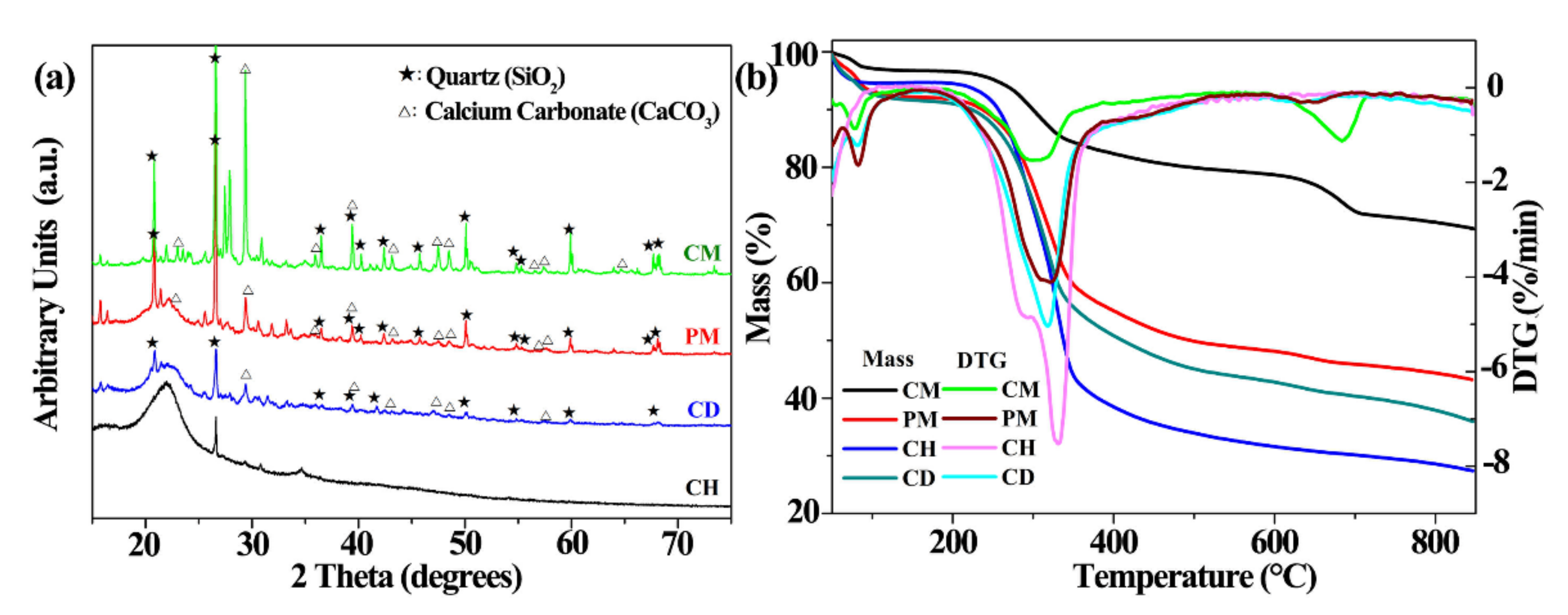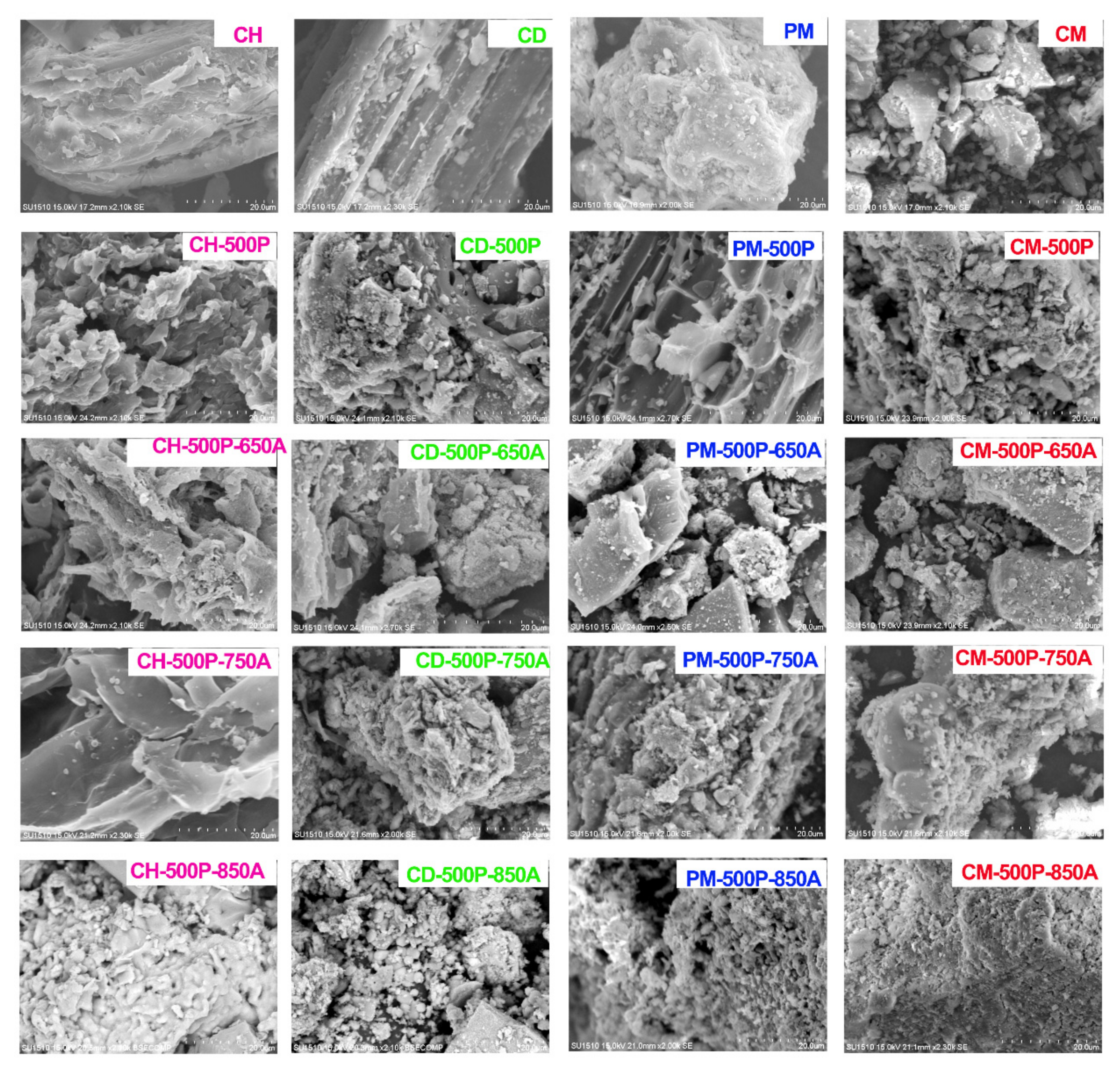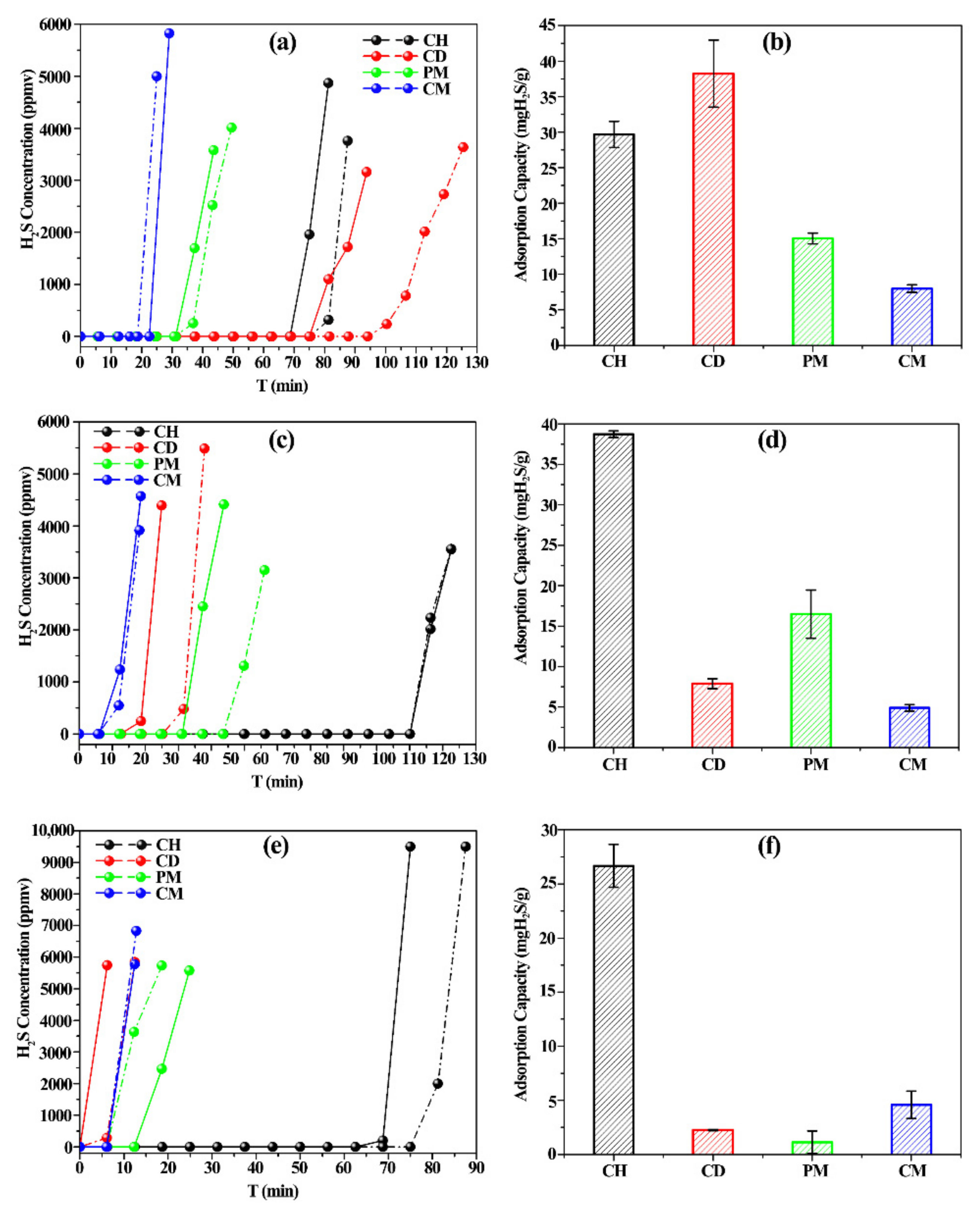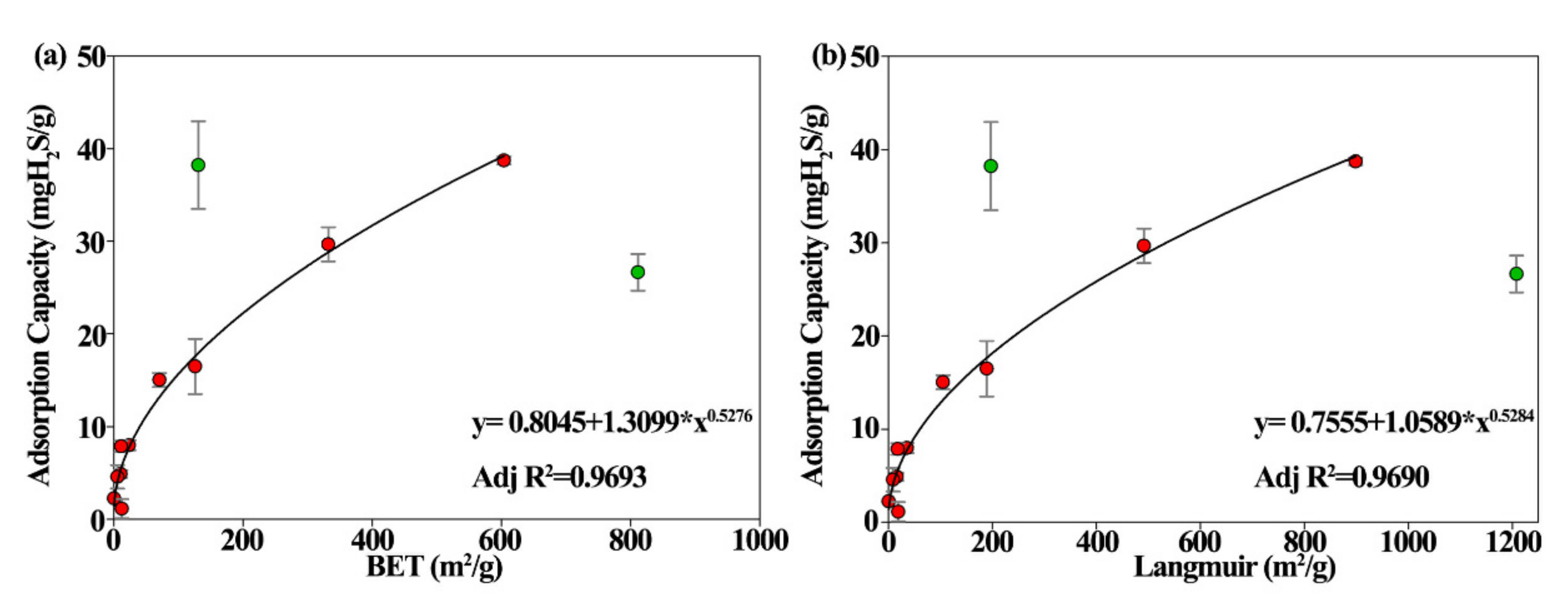Comparison of Biochar Materials Derived from Coconut Husks and Various Types of Livestock Manure, and Their Potential for Use in Removal of H2S from Biogas
Abstract
1. Introduction
2. Materials and Methods
2.1. Test Materials
2.2. Biochar Preparation and Activation Procedure
2.3. H2S Removal Experiment
2.4. Analytical Methods
3. Results and Discussions
3.1. Characteristics of Coconut Husks and Various Types of Livestock Manure
3.2. Characteristics of Livestock Manure Biochar and Activated Biochar
3.3. Fourier Transform Infrared Spectroscopy (FTIR)
3.4. Scanning Electron Microscopy
3.5. Adsorption–Desorption Isotherms and Pore Size Distributions
3.6. H2S Removal Performance of Biochar and Activated Product
4. Conclusions
Supplementary Materials
Author Contributions
Funding
Institutional Review Board Statement
Informed Consent Statement
Data Availability Statement
Acknowledgments
Conflicts of Interest
References
- Jia, W.; Qin, W.; Zhang, Q.; Wang, X.; Ma, Y.; Chen, Q. Evaluation of crop residues and manure production and their geographical distribution in China. J. Clean. Prod. 2018, 188, 954–965. [Google Scholar] [CrossRef]
- Lee, H.-J.; Ryu, H.-D.; Lim, D.Y.; Chung, E.G.; Kim, K.; Lee, J.K. Characteristics of veterinary antibiotics in intensive livestock farming watersheds with different liquid manure application programs using UHPLC-q-orbitrap HRMS combined with on-line SPE. Sci. Total Environ. 2020, 749, 142375. [Google Scholar] [CrossRef]
- Kamilaris, A.; Engelbrecht, A.; Pitsillides, A.; Prenafeta-Boldú, F.X. Transfer of manure as fertilizer from livestock farms to crop fields: The case of Catalonia. Comput. Electron. Agric. 2020, 175, 105550. [Google Scholar] [CrossRef]
- Jiang, Y.; Liang, X.; Yuan, L.; Nan, Z.; Deng, X.; Wu, Y.; Ma, F.; Diao, J. Effect of livestock manure on chlortetracycline sorption behaviour and mechanism in agricultural soil in Northwest China. Chem. Eng. J. 2021, 415, 129020. [Google Scholar] [CrossRef]
- Wu, R.-T.; Cai, Y.-F.; Chen, Y.-X.; Yang, Y.-W.; Xing, S.-C.; Liao, X.-D. Occurrence of microplastic in livestock and poultry manure in South China. Environ. Pollut. 2021, 277, 116790. [Google Scholar] [CrossRef]
- Adánez-Rubio, I.; Fonts, I.; de Blas, P.; Viteri, F.; Gea, G.; Alzueta, M.U. Exploratory study of polycyclic aromatic hydrocarbons occurrence and distribution in manure pyrolysis products. J. Anal. Appl. Pyrolysis 2021, 155, 105078. [Google Scholar] [CrossRef]
- Atienza-Martínez, M.; Ábrego, J.; Gea, G.; Marías, F. Pyrolysis of dairy cattle manure: Evolution of char characteristics. J. Anal. Appl. Pyrolysis 2020, 145, 104724. [Google Scholar] [CrossRef]
- Khoshnevisan, B.; Duan, N.; Tsapekos, P.; Awasthi, M.K.; Liu, Z.; Mohammadi, A.; Angelidaki, I.; Tsang, D.C.W.; Zhang, Z.; Pan, J.; et al. A critical review on livestock manure biorefinery technologies: Sustainability, challenges, and future perspectives. Renew. Sustain. Energy Rev. 2021, 135, 110033. [Google Scholar] [CrossRef]
- Zubair, M.; Wang, S.; Zhang, P.; Ye, J.; Liang, J.; Nabi, M.; Zhou, Z.; Tao, X.; Chen, N.; Sun, K.; et al. Biological nutrient removal and recovery from solid and liquid livestock manure: Recent advance and perspective. Bioresour. Technol. 2020, 301, 122823. [Google Scholar] [CrossRef] [PubMed]
- Liu, Z.; Wang, Z.; Tang, S.; Liu, Z. Fabrication, characterization and sorption properties of activated biochar from livestock manure via three different approaches. Resour. Conserv. Recycl. 2021, 168, 105254. [Google Scholar] [CrossRef]
- Ershadi, S.Z.; Dias, G.; Heidari, M.D.; Pelletier, N. Improving nitrogen use efficiency in crop-livestock systems: A review of mitigation technologies and management strategies, and their potential applicability for egg supply chains. J. Clean. Prod. 2020, 265, 121671. [Google Scholar] [CrossRef]
- Akdeniz, N. A systematic review of biochar use in animal waste composting. Waste Manag. 2019, 88, 291–300. [Google Scholar] [CrossRef]
- Song, J.; Wang, Y.; Zhang, S.; Song, Y.; Xue, S.; Liu, L.; Lvy, X.; Wang, X.; Yang, G. Coupling biochar with anaerobic digestion in a circular economy perspective: A promising way to promote sustainable energy, environment and agriculture development in China. Renew. Sustain. Energy Rev. 2021, 144, 110973. [Google Scholar] [CrossRef]
- Romero, C.M.; Li, C.; Owens, J.; Ribeiro, G.O.; McAllister, T.A.; Okine, E.; Hao, X. Nutrient cycling and greenhouse gas emissions from soil amended with biochar-manure mixtures. Pedosphere 2021, 31, 289–302. [Google Scholar] [CrossRef]
- Song, H.-J.; Kim, S.; Cho, Y. Removal of heavy metals using sorbents derived from bark. J. Porous Mater. 2020, 27, 319–328. [Google Scholar] [CrossRef]
- Sulok, K.M.T.; Ahmed, O.H.; Khew, C.Y.; Zehnder, J.A.M.; Jalloh, M.B.; Musah, A.A.; Abdu, A. Chemical and Biological Characteristics of Organic Amendments Produced from Selected Agro-Wastes with Potential for Sustaining Soil Health: A Laboratory Assessment. Sustainability 2021, 13, 4919. [Google Scholar] [CrossRef]
- Meier, S.; Curaqueo, G.; Khan, N.; Bolan, N.; Cea, M.; Eugenia, G.M.; Cornejo, P.; Ok, Y.S.; Borie, F. Chicken-manure-derived biochar reduced bioavailability of copper in a contaminated soil. J. Soil. Sediment. 2017, 17, 741–750. [Google Scholar] [CrossRef]
- Yu, G.; Wu, X.; Wei, L.; Zhou, Z.; Liu, W.; Zhang, F.; Qu, Y.; Ren, Z. Desulfurization of diesel fuel by one-pot method with morpholinium-based Brønsted acidic ionic liquid. Fuel 2021, 296, 120551. [Google Scholar] [CrossRef]
- Neubauer, R.; Weinlaender, C.; Kienzl, N.; Bitschnau, B.; Schroettner, H.; Hochenauer, C. Adsorptive on-board desulfurization over multiple cycles for fuel-cell-based auxiliary power units operated by different types of fuels. J. Power Sources 2018, 385, 45–54. [Google Scholar] [CrossRef]
- El-hoshoudy, A.N.; Soliman, F.S.; Abd El-Aty, D.M. Extractive desulfurization using choline chloride-based DES/molybdate nanofluids; Experimental and theoretical investigation. J. Mol. Liq. 2020, 318, 114307. [Google Scholar] [CrossRef]
- Saha, B.; Vedachalam, S.; Dalai, A.K. Review on recent advances in adsorptive desulfurization. Fuel Process. Technol. 2021, 214, 106685. [Google Scholar] [CrossRef]
- Choudhury, A.; Lansing, S. Biochar addition with Fe impregnation to reduce H2S production from anaerobic digestion. Bioresour. Technol. 2020, 306, 123121. [Google Scholar] [CrossRef] [PubMed]
- Hervy, M.; Pham Minh, D.; Gérente, C.; Weiss-Hortala, E.; Nzihou, A.; Villot, A.; Le Coq, L. H2S removal from syngas using wastes pyrolysis chars. Chem. Eng. J. 2018, 334, 2179–2189. [Google Scholar] [CrossRef]
- Yang, E.; Yao, C.; Liu, Y.; Zhang, C.; Jia, L.; Li, D.; Fu, Z.; Sun, D.; Robert Kirk, S.; Yin, D. Bamboo-derived porous biochar for efficient adsorption removal of dibenzothiophene from model fuel. Fuel 2018, 211, 121–129. [Google Scholar] [CrossRef]
- Jung, S.; Kim, J.-H.; Lee, D.-J.; Lin, K.-Y.A.; Tsang, Y.F.; Yoon, M.-H.; Kwon, E.E. Virtuous utilization of biochar and carbon dioxide in the thermochemical process of dairy cattle manure. Chem. Eng. J. 2021, 416, 129110. [Google Scholar] [CrossRef]
- Awasthi, S.K.; Duan, Y.; Liu, T.; Zhou, Y.; Qin, S.; Liu, H.; Varjani, S.; Awasthi, M.K.; Zhang, Z.; Pandey, A.; et al. Sequential presence of heavy metal resistant fungal communities influenced by biochar amendment in the poultry manure composting process. J. Clean. Prod. 2021, 291, 125947. [Google Scholar] [CrossRef]
- Li, X.; Zhan, Y.; Su, L.; Chen, Y.; Chen, M.; Zhang, L.; Zhen, G.; Han, Z.; Chai, X. Sequestration of Sulphide from Biogas by thermal-treated iron nanoparticles synthesized using tea polyphenols. Environ. Technol. 2020, 41, 741–750. [Google Scholar] [CrossRef]
- Su, L.; Liu, C.; Liang, K.; Chen, Y.; Zhang, L.; Li, X.; Han, Z.; Zhen, G.; Chai, X.; Sun, X. Performance evaluation of zero-valent iron nanoparticles (NZVI) for high-concentration H2S removal from biogas at different temperatures. RSC Adv. 2018, 8, 13798–13805. [Google Scholar] [CrossRef]
- Maljaee, H.; Madadi, R.; Paiva, H.; Tarelho, L.; Ferreira, V.M. Incorporation of biochar in cementitious materials: A roadmap of biochar selection. Constr. Build. Mater. 2021, 283, 122757. [Google Scholar] [CrossRef]
- Zhang, Y.; Kawasaki, Y.; Oshita, K.; Takaoka, M.; Minami, D.; Inoue, G.; Tanaka, T. Economic assessment of biogas purification systems for removal of both H2S and siloxane from biogas. Renew. Energy 2021, 168, 119–130. [Google Scholar] [CrossRef]
- Wang, X.; Zhai, M.; Guo, H.; Panahi, A.; Dong, P.; Levendis, Y.A. High-temperature pyrolysis of biomass pellets: The effect of ash melting on the structure of the char residue. Fuel 2021, 285, 119084. [Google Scholar] [CrossRef]
- Lu, Z.; Zhang, H.; Shahab, A.; Zhang, K.; Zeng, H.; Bacha, A.-U.-R.; Nabi, I.; Ullah, H. Comparative study on characterization and adsorption properties of phosphoric acid activated biochar and nitrogen-containing modified biochar employing Eucalyptus as a precursor. J. Clean. Prod. 2021, 12, 127046. [Google Scholar] [CrossRef]
- Peter, A.; Chabot, B.; Loranger, E. Enhanced activation of ultrasonic pre-treated softwood biochar for efficient heavy metal removal from water. J. Environ. Manag. 2021, 290, 112569. [Google Scholar] [CrossRef]
- Yao, Q.; Borjihan, Q.; Qu, H.; Guo, Y.; Zhao, Z.; Qiao, L.; Li, T.; Dong, A.; Liu, Y. Cow dung-derived biochars engineered as antibacterial agents for bacterial decontamination. J. Environ. Sci. 2021, 105, 33–43. [Google Scholar] [CrossRef]
- Ma, Q.; Chen, W.; Jin, Z.; Chen, L.; Zhou, Q.; Jiang, X. One-step synthesis of microporous nitrogen-doped biochar for efficient removal of CO2 and H2S. Fuel 2021, 289, 119932. [Google Scholar] [CrossRef]
- Maziarka, P.; Wurzer, C.; Arauzo, P.J.; Dieguez-Alonso, A.; Mašek, O.; Ronsse, F. Do you BET on routine? The reliability of N2 physisorption for the quantitative assessment of biochar’s surface area. Chem. Eng. J. 2021, 418, 129234. [Google Scholar] [CrossRef]
- Wang, C.; Li, L.; Shi, J.; Jin, H. Biochar production by coconut shell gasification in supercritical water and evolution of its porous structure. J. Anal. Appl. Pyrolysis 2021, 156, 105151. [Google Scholar] [CrossRef]







| Parameter | CH | CD | PM | CM |
|---|---|---|---|---|
| pH | 6.15 ± 0.07 | 10.55 ± 0.01 | 10.05 ± 0.02 | 10.34 ± 0.04 |
| EC (μs/cm) | 2.09 ± 0.04 | 8.73 ± 0.48 | 4.23 ± 0.13 | 3.45 ± 0.16 |
| Moisture content (%) | 15.09 ± 0.30 | 11.64 ± 0.41 | 12.93 ± 0.13 | 8.30 ± 0.11 |
| VS (%) | 96.16 ± 0.02 | 78.83 ± 2.00 | 69.82 ± 0.61 | 40.66 ± 1.01 |
| Density (g/cm3) | 0.428 | 0.418 | 0.757 | 0.776 |
| Si (mg/g) | 0.15 | 0.95 | 0.96 | 1.65 |
| Fe (mg/g) | 0.46 | 2.05 | 3.51 | 9.56 |
| Ca (mg/g) | 1.36 | 17.93 | 26.46 | 65.44 |
| Al (mg/g) | 0.09 | 0.54 | 1.20 | 2.97 |
| Na (mg/g) | 1.18 | 8.67 | 2.63 | 1.83 |
| Mg (mg/g) | 0.63 | 6.35 | 6.98 | 7.57 |
| K (mg/g) | 6.90 | 41.75 | 12.05 | 13.16 |
| Zn (mg/g) | 0.03 | 0.18 | 2.23 | 0.21 |
| Cu (mg/g) | 0.03 | 0.04 | 0.58 | 0.04 |
| Cr (mg/g) | 0.01 | 0.07 | 0.16 | 0.36 |
| Mn (mg/g) | 0.01 | 0.17 | 0.50 | 0.42 |
| Ba (mg/g) | 0.04 | 0.03 | 0.03 | 0.06 |
| Ni (mg/g) | 0.06 | <0.01 | 0.01 | 0.02 |
| Cd (mg/g) | <0.01 | <0.01 | <0.01 | <0.01 |
| P (mg/g) | 0.64 | 0.64 | 12.88 | 10.73 |
| Sample | pH | BET (m2/g) | Density (g/cm3) | Burn Off (%) |
|---|---|---|---|---|
| CH–500P | 10.5 | 0.18 | 0.415 | 79.37 |
| CD–500P | 10.5 | 7.01 | 0.415 | 64.95 |
| PM–500P | 9.5 | 6.89 | 0.752 | 57.07 |
| CM–500P | 9.7 | 11.84 | 0.769 | 29.28 |
| Sample | pH | Surface Area | Density (g/cm3) | Burn Off (%) | |
|---|---|---|---|---|---|
| BET (m2/g) | Langmuir (m2/g) | ||||
| CH–500P–650A | 10.4 | 331.86 | 491.07 | 0.413 | 21.29 |
| CD–500P–650A | 10.4 | 130.80 | 197.03 | 0.399 | 29.45 |
| PM–500P–650A | 9.6 | 70.54 | 104.79 | 0.707 | 14.60 |
| CM–500P–650A | 9.4 | 23.55 | 35.56 | 0.758 | 11.37 |
| CH–500P–750A | 10.3 | 604.13 | 898.55 | 0.398 | 36.05 |
| CD–500P–750A | 10.3 | 11.28 | 17.74 | 0.395 | 55.95 |
| PM–500P–750A | 9.4 | 125.80 | 188.86 | 0.709 | 22.15 |
| CM–500P–750A | 10.3 | 10.45 | 15.78 | 0.755 | 21.13 |
| CH–500P–850A | 11.0 | 811.46 | 1208.03 | 0.378 | 75.04 |
| CD–500P–850A | 10.2 | 0.26 | 0.38 | 0.391 | 59.43 |
| PM–500P–850A | 9.9 | 12.30 | 18.78 | 0.689 | 43.76 |
| CM–500P–850A | 11.7 | 5.65 | 8.73 | 0.743 | 22.42 |
| Activation Temperature (°C) | CH (mg H2S/g) | CD (mg H2S/g) | PM (mg H2S/g) | CM (mg H2S/g) |
|---|---|---|---|---|
| / | 30.44 | 29.81 | 13.82 | 10.96 |
| 650 | 29.68 | 38.23 | 15.03 | 7.98 |
| 750 | 38.73 | 7.87 | 16.49 | 4.90 |
| 850 | 26.67 | 1.13 | 4.57 | 2.25 |
Publisher’s Note: MDPI stays neutral with regard to jurisdictional claims in published maps and institutional affiliations. |
© 2021 by the authors. Licensee MDPI, Basel, Switzerland. This article is an open access article distributed under the terms and conditions of the Creative Commons Attribution (CC BY) license (https://creativecommons.org/licenses/by/4.0/).
Share and Cite
Su, L.; Chen, M.; Zhuo, G.; Ji, R.; Wang, S.; Zhang, L.; Zhang, M.; Li, H. Comparison of Biochar Materials Derived from Coconut Husks and Various Types of Livestock Manure, and Their Potential for Use in Removal of H2S from Biogas. Sustainability 2021, 13, 6262. https://doi.org/10.3390/su13116262
Su L, Chen M, Zhuo G, Ji R, Wang S, Zhang L, Zhang M, Li H. Comparison of Biochar Materials Derived from Coconut Husks and Various Types of Livestock Manure, and Their Potential for Use in Removal of H2S from Biogas. Sustainability. 2021; 13(11):6262. https://doi.org/10.3390/su13116262
Chicago/Turabian StyleSu, Lianghu, Mei Chen, Guihua Zhuo, Rongting Ji, Saier Wang, Longjiang Zhang, Mingzhu Zhang, and Haidong Li. 2021. "Comparison of Biochar Materials Derived from Coconut Husks and Various Types of Livestock Manure, and Their Potential for Use in Removal of H2S from Biogas" Sustainability 13, no. 11: 6262. https://doi.org/10.3390/su13116262
APA StyleSu, L., Chen, M., Zhuo, G., Ji, R., Wang, S., Zhang, L., Zhang, M., & Li, H. (2021). Comparison of Biochar Materials Derived from Coconut Husks and Various Types of Livestock Manure, and Their Potential for Use in Removal of H2S from Biogas. Sustainability, 13(11), 6262. https://doi.org/10.3390/su13116262






